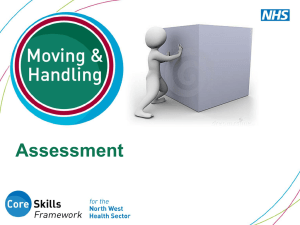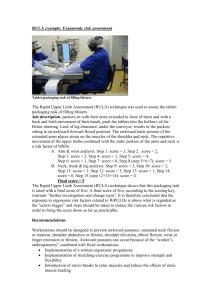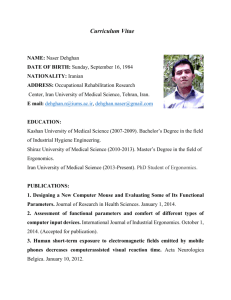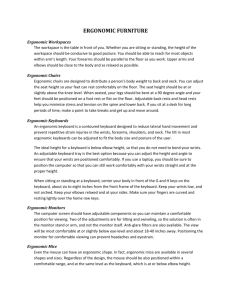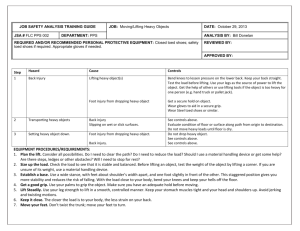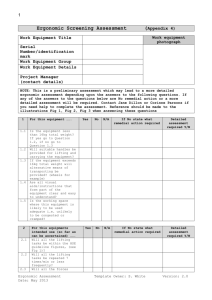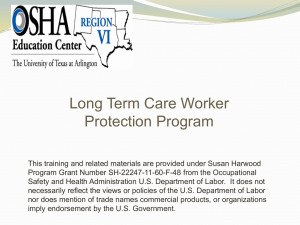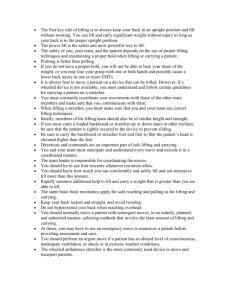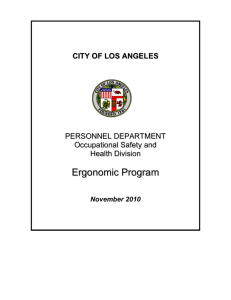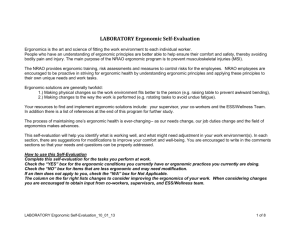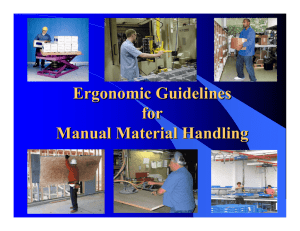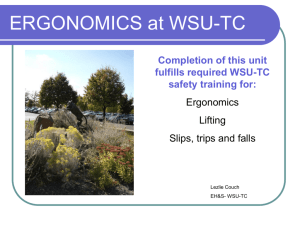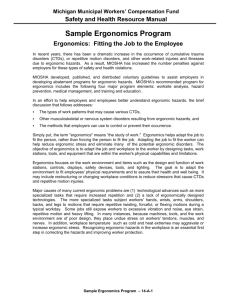Chapter 7: Ergonomics and Safe Lifting
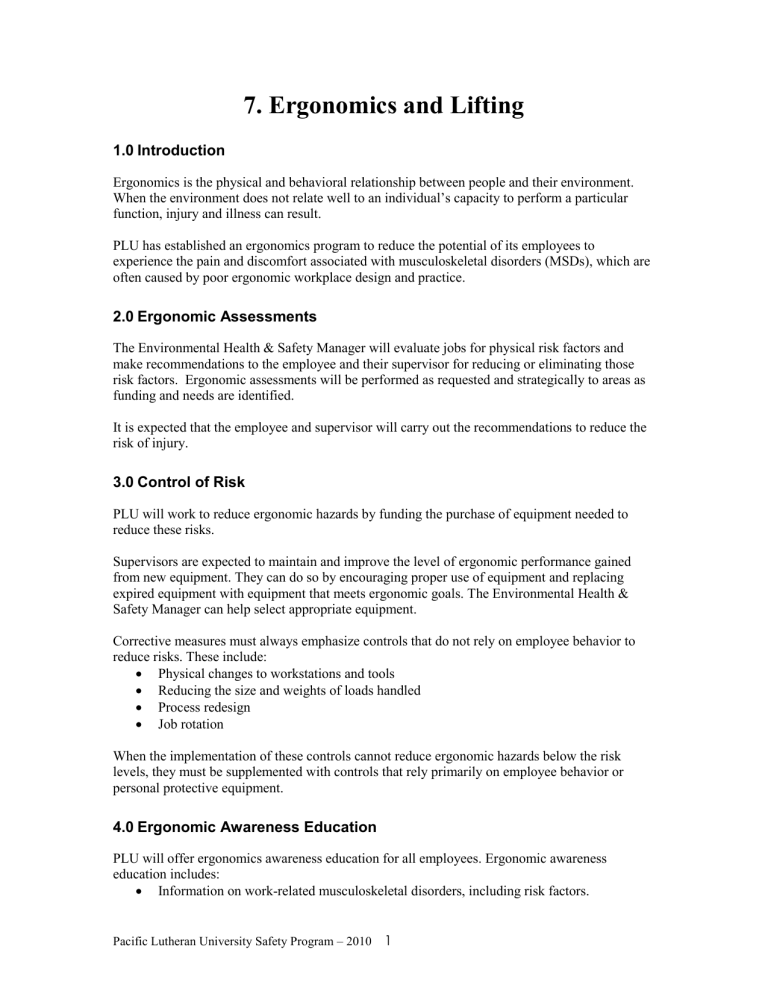
7. Ergonomics and Lifting
1.0 Introduction
Ergonomics is the physical and behavioral relationship between people and their environment.
When the environment does not relate well to an individual’s capacity to perform a particular function, injury and illness can result.
PLU has established an ergonomics program to reduce the potential of its employees to experience the pain and discomfort associated with musculoskeletal disorders (MSDs), which are often caused by poor ergonomic workplace design and practice.
2.0 Ergonomic Assessments
The Environmental Health & Safety Manager will evaluate jobs for physical risk factors and make recommendations to the employee and their supervisor for reducing or eliminating those risk factors. Ergonomic assessments will be performed as requested and strategically to areas as funding and needs are identified.
It is expected that the employee and supervisor will carry out the recommendations to reduce the risk of injury.
3.0 Control of Risk
PLU will work to reduce ergonomic hazards by funding the purchase of equipment needed to reduce these risks.
Supervisors are expected to maintain and improve the level of ergonomic performance gained from new equipment. They can do so by encouraging proper use of equipment and replacing expired equipment with equipment that meets ergonomic goals. The Environmental Health &
Safety Manager can help select appropriate equipment.
Corrective measures must always emphasize controls that do not rely on employee behavior to reduce risks. These include:
Physical changes to workstations and tools
Reducing the size and weights of loads handled
Process redesign
Job rotation
When the implementation of these controls cannot reduce ergonomic hazards below the risk levels, they must be supplemented with controls that rely primarily on employee behavior or personal protective equipment.
4.0 Ergonomic Awareness Education
PLU will offer ergonomics awareness education for all employees. Ergonomic awareness education includes:
Information on work-related musculoskeletal disorders, including risk factors.
Pacific Lutheran University Safety Program – 2010
1
Types, symptoms, and consequences of WMSDs and the importance of early reporting.
Information on identifying WMSD hazards and common measures to reduce them.
5.0 Equipment Selection and Purchase
The Environmental Health and Safety Office and/or Business Office will identify potential vendors to provide ergonomic furniture options to assist employees in selecting furniture for their offices that meet the objectives of this program. The Environmental Health & Safety Manager will be consulted for furniture, process equipment, and other large equipment purchases to ensure that we do not create any ergonomic risk factors.
Funding is currently provided through the capital equipment budget to reduce ergonomic risks to a degree. After that money is no longer available, it may become the responsibility of each department to provide ergonomic equipment for new or altered workstations to meet the objectives of this program.
It is the responsibility of each department and supervisor, when investing in new equipment, to do so with equipment that reduces ergonomic hazards to the highest degree technologically and economically feasible. Please consult the Environmental Health & Safety Manager for guidance on this.
6.0 Ergonomic Hazard Contributing Factors
The following are contributing factors for ergonomic injuries. Please try to limit or avoid activities with these risk factors.
Repetition Repetition
Force
Vibration
Temperature
Contact Stress
A wk w ar d
Posture
S_u_s_t_a_i_n_e_d Exertions
Pressure
7.0 Actions to Minimize Strain
It is helpful to interrupt continuous work with periodic rest breaks or other work activities. The following are additional corrective measures.
7.1 Maintain Good Posture
To prevent neck and back strain, keep your spine and head upright, and sit well back into your chair. Placing your feet on a surface rather than allowing them to dangle helps take the strain off your legs and back.
7.2 Correct Hand and Wrist Placement
Shoulder muscles can become tense when arms and hands are held too high. Hold arms comfortably at your side, with your elbow at about a right angle. Wrists should be in line with
Pacific Lutheran University Safety Program – 2010
2
the forearm; wrist problems, such as carpel tunnel, can develop when wrists are bent at extreme angles.
7.3 Use of Hand, Wrist or Arm Supports
These can prove useful in reducing or relieving physical stresses that result from having the arm suspended for a length of time in a static position.
7.4 Proper Eye Care
To lessen the strain on eye muscles, keep your monitor screen at least 18 to 28 inches from your eyes. Take vision breaks, look at an object at least 20 feet away from time to time.
7.5 Head and neck
Position your head and neck with the top of the screen at about eye level and perpendicular to the viewing direction.
7.6 Shoulders
To lessen shoulder tension the keyboard should be low enough so that the arms hang freely, the shoulders are not lifted, and elbows are bent at right angles.
7.7 Lower Back
For support of the lower back a properly designed chair is necessary. Height should be adjusted to permit correct placement of the head and hands of the operator as indicated elsewhere in this section. Knees should be at about the same level as your hips. There should be about three finger widths between the back of your knee and the front edge of the chair.
7.8 Stretching and Exercise
Exercise will help relax tight muscles, reduce stress and lessen general fatigue. Stretching, moving of hands, fingers, arms and wrists in a variety of other positions and gentle rubbing of hand and arm muscles are helpful in relieving strain.
7.9 Position Work
Position work to prevent slouching in your neck. Try placing your work materials on a document holder, so you do not have to lean over your desk.
8.0 Preventing Lifting Injuries
Pacific Lutheran University is committed to helping reduce back injuries at work by emphasizing good lifting techniques, but basic safety is a shared responsibility—it requires your constant awareness of these techniques whenever you lift, both on and off the job.
8.1 How to Lift Properly
The following principles are provided to promote proper lifting techniques:
Size up the load.
Test it to see if you can lift it safely. Can you grasp it securely? Place hands on opposite corners for balance. Make sure you have a good handhold on the load.
Get help when the load is too heavy or awkward to lift alone
Break the load down into smaller components, if possible, to provide a comfortable lift.
Do not overexert!
Make sure your footing is secure. Do not lift objects that obscure vision or footing.
Pacific Lutheran University Safety Program – 2010
3
Do not twist while lifting. Turn your feet in the direction of travel when moving the load in another direction.
Do not lift while in an awkward position. Avoid long forward reaches to lift over an obstruction.
Lift smoothly and slowly. Do not jerk the load. Lift the load in a smooth and controlled manner.
Organize the work so as to avoid lifting from the floor or above shoulder level, especially with very heavy items. Items to be handled should be between knee and shoulder height.
Position the load properly. Keep the load as close to the body as possible. If the load is large and cannot be placed between the knees as they are bent, bend at the hips and waist with the knees relaxed. It is more important to keep the load close than it is to bend the knees. The best solution to lifting a larger load (aside from having mechanical assistance) is to get another person to help you.
Mechanical devises. If the lifts must be done many times, use mechanical devices, such as a PIT, hoist, hand truck or adjustable table, to avoid over-fatigue. Use of repetitive squat lifts is very fatiguing. Rest between lifts when you cannot use a mechanical device to assist you.
Alternate tasks. Alternate lifting tasks with lighter tasks.
Lowering or placing the load. Use the same principles when lowering or placing the load after lifting.
Avoid bending backwards to loft or place items above your shoulder. Use a step stool or platform to elevate the body, keeping the load between the knee and shoulder to place an item on a high surface.
Longer distances. Avoid carrying the load more than 10 feet without getting mechanical assistance, such as a dolly or cart.
Back injuries are painful for the worker and one of the leading causes of workers compensation claims. And they are almost always avoidable. Lift safely!
Pacific Lutheran University Safety Program – 2010
4

